Not as hard as you think, thanks to this Maasdam demonstration
Ever wonder how to make one of those beautiful fruit carvings to accentuate your dining room table? Or tried doing them? My own attempts always end in total disaster so today I’m attending a seminar at the Maasdam’s Culinary Arts Center to see if there’s any hope for me.
Cat Noble, the Maasdam’s Party Planner, introduces Apprentice Chef Romel David who will demonstrate how to make carvings from various fruits and vegetables.
He begins with a watermelon, intending to create a rose petal with leaves on one side. Using an extremely sharp bread knife, he first slices off the bottom of the melon to make a base with a gentle tilt. Next, with the same bread knife, he carefully cuts away several thin strips of green rind to expose the white covering beneath. This gives Romel a white background from which to fashion his rose.
Cat explains one side of the melon is for display while the other side is what you will eventually serve from.
As Romel picks up a small paring knife, he explains that it doesn’t matter how expensive your knife is—he buys his at a dollar store–but how sharp it is. He says he sharpens his own knives. The one he uses today has been ground down to half the size of a normal paring knife blade.
In the middle of his white melon “canvas,” Romel makes a small circle to form the center of the rose. Around the center, he designs four petals to surround it. To me, this looks like a stencil on the white rind; interesting. I can do that!
After his basic design is outlined, Romel begins cutting deeper, carefully shaping and forming each petal. Then he fashions four larger petals that surround the four small ones. Next, he finishes by crafting six leaves. As he works, each row increases in size and is placed to alternate with the previous row to create the depth and dimension of a real rose petal.
Once he finishes the floral design, Romel carves zigzagging cuts on the remaining white background area to give it a textured detail and create a frame around the melon canvas.
Cat says, “The best way to keep the melon fresh is to drape it with wet paper towels and store it in the refrigerator. When you take it out to display, put plastic wrap over the carved area.” So that explains why some of the carvings displayed in the Maasdam’s dining areas are covered in plastic.
Chef Romel explains he became interested in how making fruit and vegetable carvings by watching others. Then he began sneaking food into his room to practice. He says his favorite thing to carve is ice and that last year he made a large dragon for a captain’s farewell party.
The next item Romel chooses to carve is a tomato. I feel more confident about this than attempting a watermelon. With his same dollar store knife, he starts peeling the skin off the top of the tomato and continues he reaches the bottom. The peeling is a long continuous strip about ¾ inch wide.
Next, he takes the long strip and simply keeps curling it until it becomes a flower blossom. He says to use the rest of the tomato in a salad, garnishing it with the edible flower.
For his final demonstration, Romel chooses a lemon. This is another one I feel confident at attempting, especially when lemons sell seasonally at six for $1.
Romel cuts the lemon in half, then cuts a base out of one of the halves. With his magic knife, he peels a thin, ¼-inch continuous strip of lemon rind from the half but does not cut it from the lemon. Next, he takes the free end of the strip of rind and circles it around the end attached to the lemon to create a loop knot. Place a piece of parsley inside the loop and you have the perfect garnish to add to any seafood plate.
This seminar is a lot of fun with good ideas about how to give home dining and entertaining the same extra flair you find on the Maasdam. I only worry about grinding the super sharp knives and my clumsy fingers.
By Linda O’Keefe

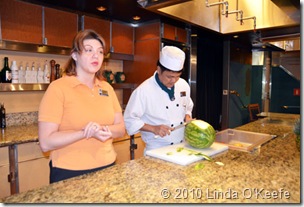
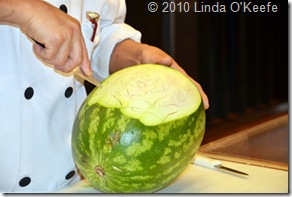
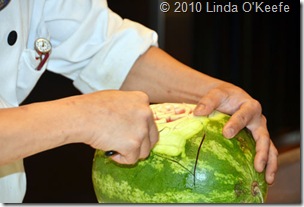
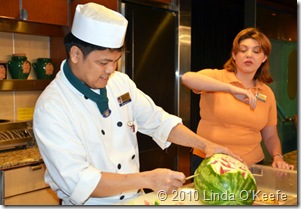
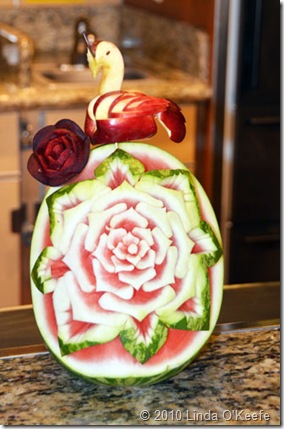
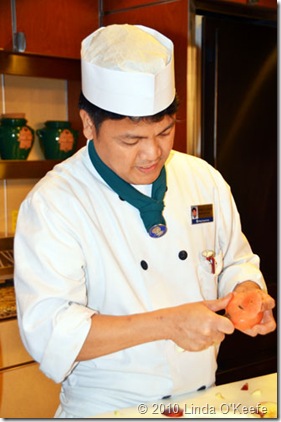
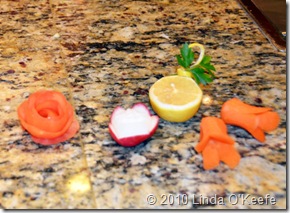
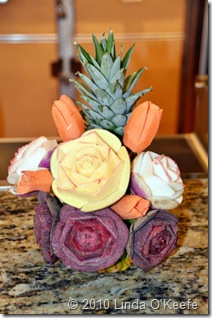
 Follow
Follow